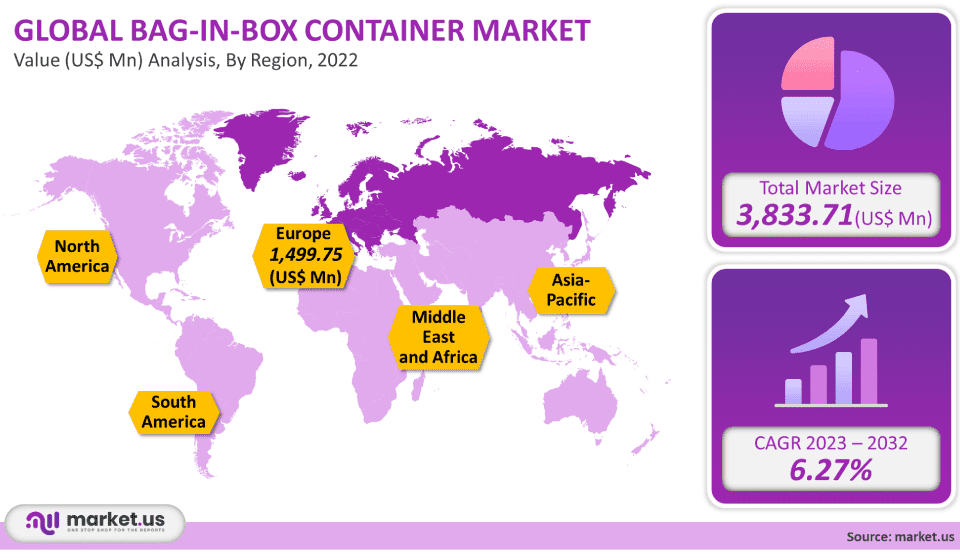Global Bag-in-Box Container Market; By Application (Food & Beverage, Industrial Liquids, and Household Products); By Capacity (751 & Above Liters, 151 to 750 Liters, 21 to 150 Liters, and Upto 20 Liters); as well as By Region and Companies - Industry Segment Outlook, Market Assessment, Competition Scenario, Trends and Forecast: 2023-2032
- Published date: May 2023
- Report ID: 34569
- Number of Pages: 219
- Format:
- keyboard_arrow_up
Quick Navigation
Report Overview
The Bag-in-Box Container Market size is expected to be worth around USD 7,042.49 million by 2032 from USD 3833.71 million in 2022, growing at a CAGR of 6.27% during the forecast period from 2022 to 2032.
This industry’s growth can be attributed largely to increasing product adoption in various industry segments, such as household cleaners, alcoholic beverages, as well as milk and cheese products.

Global Bag-in-Box Container Market Scope:
Application Analysis:
Based on ‘Application’, the food & beverage sector accounted for 66% of total terms revenue in 2021. Hygienic types of packaging solutions will be in demand due to growing health concerns, increasing disposable incomes, and the surging number of older people living in developing countries. Higher demand for food products and beverage products has been fueled by the need to lead healthier lifestyles, and a better awareness of healthier products. Major segment growth drivers for this industry in the future will be the introduction of packaging solutions that make products easy to consume, as well as the development of various new soft drinks.
Manufacturers also offer a wider range of product options, such as healthier snacks and innovative packaging, thus adding nutritional products to their existing product lines. This is a significant market growth element driving the market for bag-in-box containers.
Market growth factors are also expected to be fueled by increasing consumer concerns regarding personal hygiene and the higher use of household cleaners over the forecast period. This segment is expected to index a surge in the demand for household cleaners like fabric fresheners and surface deodorizers.
Capacity Analysis:
The 151 to 750 liters capacity bag-in-box products are highly desired for large-quantity exports. Manufacturers in the highly innovative packaging sector are looking into the optimal uses for each packaging product they manufacture. Similar to this, the producers and marketers promoted bag-in-box as a useful packing item with several business-to-business uses.
Bag-in-boxes are most frequently used to transport big volumes of drinks and other liquid items, and their most popular capacity ranges from 151 to 750 Liters. Over the next ten years, it is anticipated that sales of bag-in-box packaging with capacities between 151 and 750 Liters would increase by US$575 Mn.
Key Market Segments:
Basis of Application
- Food & Beverage
- Non-Alcoholic Beverages
- Alcoholic Beverages
- Other Food & Beverages
- Industrial Liquids
- Petroleum Products
- Industrial Fluids
- Oils
- Household Products
- Liquid Soaps & Handwash
- Liquid Detergents
- Household Cleaners
- Other Household Products
By Capacity
- 751 & Above Liters
- 151 to 750 Liters
- 21 to 150 Liters
- Upto 20 Liters
Market Dynamics:
The wine industry is a primary element causing a boom in sales for the bag-in-box container market growth. As manufacturers adopt advanced sustainable packaging solutions like bag-in-box containers, wine production is expected to continue growing. Due to the increasing consumption of alcoholic beverages, particularly in developed countries, this market for bag-in-box containers in the alcoholic beverage companies category is expected to grow exponentially. North America will be the largest consumer, followed by the largest market leaders in Europe.
Over the forecast period, the market trends for bag-in-box containers will be driven by the growing demand for household products. This segment is expected to register a surge in household cleaning products like surface deodorizers, and cleaners. A spike in urban populations has also led to a greater rise in demand for hygiene-promoting products like household cleaners. This market’s growth will also be complemented by the use of low-foam detergents packaged in bag-in-box containers.
Parallel growth in the substitute product market, like that of plastic or glass bottles, is expected to potentially limit the demand for bag-in-box containers. The availability of cheaper plastic bottles is also expected to hinder growth. Over the forecast period, this regional market will be affected by an increase in demand for plastic bottles from the soft drink sector.
Bag-in-box containers are at high risk of being replaced by other packaging materials products or materials. Pouches are the most popular products used for packaging beverages. On account of their portability and ease of use, pouches are rapidly becoming a popular choice. One can also find pouches in a variety of sizes and formats. They are available in 50ml, larger, or multi-serving formats as well. These key factors have made pouches very popular for portable use. Pouches encourage sampling from a marketing perspective.
Many players in the global market strategies are involved with technology development, including design and packaging solutions and in-depth analysis. This industry is projected to register an increase in the demand for innovative packaging designs to garner consumers’ attention.
Manufacturers are constantly coming up with innovative solutions to meet consumer demand. Elite Packaging, a U.K.-based company, has created a gusseted bag with seals in all corners. This design gives the product greater stability and efficiency. It also reduces the size of the bag-in-box container, making it easier to use.
This pandemic brought about an increase in the demand for cleaning and sanitizing products. Market opportunities with players focused on creating new packaging solutions for different cleaning products. Smurfit Kappa introduced Vitop Blue tap-to-bag-in-box cleaning products in 2020. This product was used to package hand sanitizers in bag-in-box packaging during the COVID-19 pandemic.
Regional Analysis:
Due to the adoption increase of bag-in-box containers within the type of food & beverage industries, Europe’s demand for bag-in-box containers is expected to increase by 39.12%. Market growth is slated to be driven by changing consumer habits and increasing urbanization levels. This forecast timeline will index a surge in the demand for bag-in-box containers in this region due to greater R&D investments being made by packaging manufacturers.
The Asia Pacific markets are expected to grow at 8% CAGR over the forecast period. During this timeline, the Asia Pacific food & beverage market is expected to have a positive influence on the further development of the bag-in-box container industry. Demand is expected to rise due to the increasing industrialization in India and China, as well as the growing adoption of packaged food products and beverages in the region.
Another major trend was the household product segment, largely due to the introduction of eco-cleaning household products. This market will also be driven by various technological advances, such as automatic dishwashing machines.
Throughout the forecast period, this industry size is anticipated to expand as a result of growing health concerns and a greater demand for hygiene goods. The need for packaged nutritious food items that provide advantages including food safety and quality at reasonable rates is expected to drive this market forward. Over the same period, this region’s leading food & beverage producers, including Tyson Food Inc. and Kellogg’s Co., will register market expansion.

Key Regions and Countries Covered in This Report:
- North America
- US
- Canada
- Mexico
- Europe
- Germany
- UK
- France
- Italy
- Russia
- Spain
- Rest of Europe
- APAC
- China
- Japan
- South Korea
- India
- Rest of Asia-Pacific
- South America
- Brazil
- Argentina
- Rest of South America
- MEA
- GCC
- South Africa
- Israel
- Rest of the Middle East & Africa
This Box market has a competitive landscape. Major market players are based in North America, with dedicated distribution and manufacturing facilities located around the globe. To reduce production costs and ensure a constant supply, these companies sign long-term agreements with raw material suppliers. This gives them a competitive edge and advantage over smaller local players.
Smurfit Kappa, DS Smith, and DuPont are all involved in the production and distribution of bag-in-box containers. They use high-capacity production lines and a wide range of production facilities across the region. These companies have extensive product portfolios that include products for multiple applications. Companies source raw materials from top North American suppliers, including Arkema Group and The Dow Chemical Company.
To increase market share in a specific region, companies may resort to multiple acquisitions & mergers. At times, companies form technological partnerships to produce a superior product that has higher performance characteristics. This can increase their revenue share. These organizations are also involved with the production of custom products to meet the demands of their customers.

Market Key Players:
- Amcor Ltd.
- Aran Group
- Arlington Packaging (Rental) Limited
- DS Smith
- Smurfit Kappa Group Plc
- Scholle IPN
- Fujimori Kogyo Ltd.
- Liqui-Box Corporation
- Optopack Ltd.
- SLF Packaging
- Zarcos America
- CDF Corporation
- TPS Rental Systems Ltd.
- Vine Valley Ventures LLC
- Scholle IPN
- Parish Manufacturing Inc.
- DuPont
- Hedwin Division of Zacros America
- Accurate Box Company Inc.
- Central Package and Display
- Multi-Pak USA
Other Key Players
For the Bag-in-Box Container Market research study, the following years have been considered to estimate the market size:
Attribute Report Details Market Size in 2022
USD 3833.71 million
Growth Rate
6.27%
Forecast Value in 2032
USD 7,042.49 million
Historical Years
2016-2020
Base Year
2021
Estimated Year
2022
Short Term Projection Year
2028
Projected Year
2023
Long Term Projection Year
2032
Report Coverage
Competitive Landscape, Revenue analysis, Company Share Analysis, Manufacturers Analysis, Volume by Manufacturers, Key Segments, Key company analysis, Market Trends, Distribution Channel, Market Dynamics, COVID-19 Impact Analysis, strategy for existing players to grab maximum market share, and more.
Regional Scope
North America, Europe, Asia-Pacific, South America, Middle East & Africa
Country Scope
United States, Canada and Mexico, Germany, France, UK, Russia and Italy, China, Japan, Korea, India and Southeast Asia, Brazil, Argentina, Colombia etc.Saudi Arabia, UAE, Egypt, Nigeria and South Africa
Frequently Asked Questions (FAQ)
What is the market size of Bag-in-Box Container?The Bag-in-Box Container Market size is expected to be worth around USD 7,042.49 million by 2032 from USD 3833.71 million in 2022.
What is the CAGR of Bag-in-Box Container Market?The Bag-in-Box Container Market is growing at a CAGR of 6.27% during the forecast period from 2022 to 2032.
 Bag-in-Box Container MarketPublished date: May 2023add_shopping_cartBuy Now get_appDownload Sample
Bag-in-Box Container MarketPublished date: May 2023add_shopping_cartBuy Now get_appDownload Sample - Amcor Ltd.
- Aran Group
- Arlington Packaging (Rental) Limited
- DS Smith
- Smurfit Kappa Group Plc
- Scholle IPN
- Fujimori Kogyo Ltd.
- Liqui-Box Corporation
- Optopack Ltd.
- SLF Packaging
- Zarcos America
- CDF Corporation
- TPS Rental Systems Ltd.
- Vine Valley Ventures LLC
- Parish Manufacturing Inc.
- DuPont
- Hedwin Division of Zacros America
- Accurate Box Company Inc.
- Central Package and Display
- Multi-Pak USA
- settingsSettings
Our Clients
| Single User $4,599 $3,499 USD / per unit save 24% | Multi User $5,999 $4,299 USD / per unit save 28% | Corporate User $7,299 $4,999 USD / per unit save 32% | |
|---|---|---|---|
| e-Access | |||
| Report Library Access | |||
| Data Set (Excel) | |||
| Company Profile Library Access | |||
| Interactive Dashboard | |||
| Free Custumization | No | up to 10 hrs work | up to 30 hrs work |
| Accessibility | 1 User | 2-5 User | Unlimited |
| Analyst Support | up to 20 hrs | up to 40 hrs | up to 50 hrs |
| Benefit | Up to 20% off on next purchase | Up to 25% off on next purchase | Up to 30% off on next purchase |
| Buy Now ($ 3,499) | Buy Now ($ 4,299) | Buy Now ($ 4,999) |











